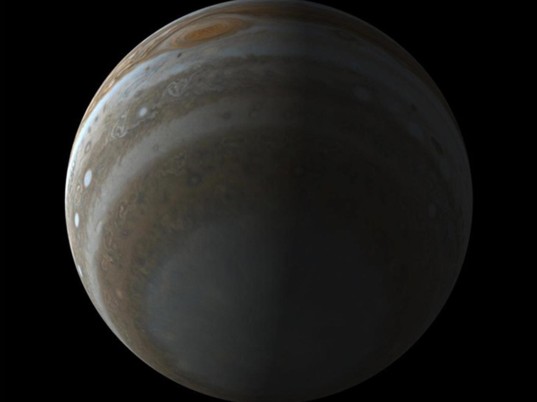 |
| Artist depiction of Juno in a polar orbit around Jupiter. Notice the large solar panels, Juno's primary source of power. Image Credit |
In July of this year, a spacecraft named Juno will enter orbit around Jupiter. While Jupiter is the most visited gas giant (many spacecrafts flyby to get a gravity boost) it has only been orbited by one spacecraft so far, Galileo. Launched in 1989, Galileo had major problems with its main antenna and its tape recorder used to store data, so although the mission completed 70% of its science goals, it was not all it could have been. It is very exciting that we will finally have another mission in Jupiter orbit this year!
| Galileo image of Jupiter's Great Red Spot. Image Credit |
| Juno's images of Earth. The two side images are in color, the center image is taken through a near-infrared filter. The bright areas are areas with high amounts of vegetation. Image Credit |
 |
| Simulated view of Jupiter's pole, likely similar to what Juno will see. Image Credit |
 |
| The first image of Jupiter taken by JunoCam. Image Credit |
The spacecraft has been cruising for 6 years, but its scientific phase is only planned for 2 years. Why such a short time? Jupiter captures intense radiation from the Sun. Mission planners have designed Juno to orbit close to Jupiter, in between Jupiter's atmosphere and the worst of the radiation, but they know the scientific instruments will likely be damaged over time. Still, within two years, Juno will have studied the entire sphere of Jupiter. The camera is only designed to last for the first 8 of the 33 planned orbits.
You can follow the mission at its website, where you can also watch a bunch of entertaining and educational videos about the mission featuring Bill Nye. I'll be sure to keep you updated on Juno news at this blog!
Stay tuned for next week's post on a mission to Mars launching in March! And of course, you can always stop by the Dome Planetarium at the Peoria Riverfront Museum to learn the latest news from space and what's up in our night sky - or Laser Floyd!
| Get tickets now! |
No comments:
Post a Comment